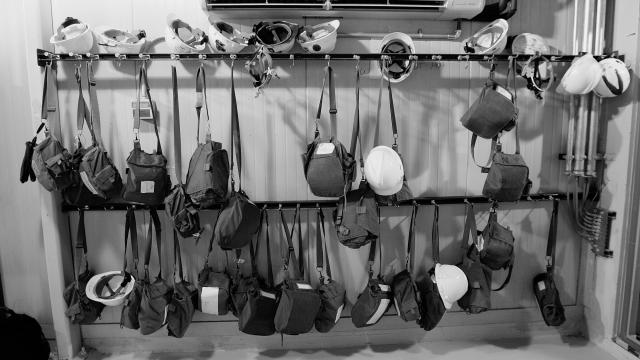Getting rid of chemical weapons is one of the military’s most unpleasant duties. But in the future, it may be no more difficult than incinerating garbage, thanks to a team of DARPA-funded scientists who think they can turn some of the world’s deadliest poisons into harmless dirt.
Hard hats and gas mask bags at the Deseret Chemical Depot in Tooele, Utah. Image: Douglas C. Pizac / AP
Chemical weapons, including nerve agents and mustards, have been banned under international law since the 1990s, but many countries still harbour large stockpiles. In 2013, a horrific chemical weapons attack in Syria — called the Ghouta attack — claimed hundreds of civilian lives, prompting the international community to intervene and eliminate the country’s chemical weapons reserves. By August 2014, 600 metric tonnes of deadly weapons had been destroyed (in the military parlance, “demilitarized”) aboard the US Navy vessel MV Cape Ray.
The Ghouta attack highlighted two things: one, that the world would be a better place if we could annihilate all chemical weapons. Two, that we really don’t have a safe method of doing so. “The Cape Ray did a great job achieving its objective, which was to demilitarize Syria’s chemical weapons,” said Dr Tyler McQuade, a chemist and program manager at DARPA’s Defence Sciences Office. “The downside is, the weapons had to be transported a long distance, and we did the demilitarization on the Mediterranean. If anything had gone wrong, it could have been really horrible for the local environment.”
Not only is transporting and destroying chemical weapons risky, the procedure for doing so, called hydrolysis, yields an elixir of nasty acids which then need to be safely disposed of. McQuade has a cleaner, safer and simple idea: burning the weapons and mixing the combustion products with soil.
“When you combust something at high enough temperatures, it breaks down into its constituent elements,” he explained when I spoke with him at a DARPA technology expo last week. “We want to scavenge that exhaust and deposit those elements back on soil.”
Soil — a complex mixture of minerals, clays and decomposing organic matter — is a natural sponge, soaking up and sequestering gases from the atmosphere. McQuade’s research has shown that when molecules similar to chemical weapons are incinerated at high temperatures, virtually all of the original material is broken down into simple gases. Some of these gases, including hydrochloric and hydrofluoric acid, would be extremely dangerous if released into the air. But in the presence of a basic soil, they’re quickly gobbled up by minerals.
The concept, called “Agnostic Compact Demilitarization of Chemical Agents“, (ACDC) yields no toxic waste products, and all of the tools are portable. One of McQuade’s set ups, a waste-to-energy engine, could run its electrical systems entirely off the power generated during combustion.
“Right now, we can destroy these molecules up to six nines,” McQuade said, indicating that the method is able to eliminate 99.9999 per cent of the original material. “We will discharge essentially nothing out of this system.”
McQuade and his team are currently conducting studies to determine how stable dangerous materials are once sequestered on soil. “There is nothing that won’t eventually leach out in water,” he said. “But we want it to be on a time frame that’s consistent with natural processes.
The first field trials of the ACDC method are slated for next autumn. If all goes well, the technology could represent a real breakthrough in our ability to rid the world of chemical weapons once and for all — and an unexpected source of fertilised soil, to boot.
